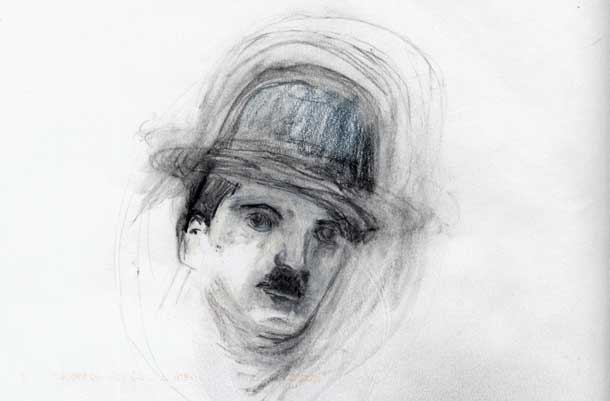THUNDER BAY – A sidebar in history about Charlie Chaplin’s earliest North American tours with Fred Karno’s Travelling Show in Canada venturing all the way to British Columbia is an alluring time. Especially when one might spend a moment understanding what took place. Fred Karno was Fred Westcott’s British troupe of Vaudeville performers. Karno’s other facility for shows, back home, was an exceptionally large Houseboat moored on the Thames River. It’s since become a musical recording studio for Pink Floyd.
However in Vancouver one summer an Orpheum season ticketholder spoke to me about Chaplin, “Tes, the very young Charlie Chaplin was here with Karno. Though Chaplin would have been at the original Orpheum Theatre on Porter and Howe. Britain’s Karno Company and Chaplin were connecting on both sides of the border”.
Chaplin, and other performers, had sailed the Atlantic after departing from London in a crossing that took 12 days. They were on a cattle boat. There were rats galore putting on such animated antics. To the point where Chaplin wrote, “The rats perched arrogantly at my bunk until I threw a shoe at them.”
They went along the St Lawrence in overcast drizzling weather Chaplin would say, “Quebec looked like the ramparts where Hamlet’s ghost might have walked”.
The weather cleared. Chaplin, “The country became increasingly beautiful in autumn colours. I became hopeful”.
They did a New York show. The year was 1912. Though Chaplin had travelled like this before. Enter Canadian Mack Sennett, who ran the Keystone Film Company, sat in the audience looking for fresh talent. Sennett was originally from Quebec. Though his family moved to Conneticut when he was 17. He was accompanied by Mabel Normand the lady whom others said had Betty Boop eyes.
Both Sennett and Normand were thrilled with what they experienced.
They mutually agreed they’d seen enough of this child prodigy, this kid rising from London’s slums, to eventually promote Chaplin’s career.
It was at the American Theatre on 42nd Street where the world of Charlie Chaplin would receive such a lift. Sennett was touched by Chaplin’s showmanship in the evening’s very lively exchange of A Night in an English Music Hall. As the scouting of Chaplin’s career goes either Sennett or Harry Aiken, the other major stock holder in the Keystone Comedies, were part and parcel in hiring Chaplin to his first professional contract in film.
Chaplin was just 19 years old.
Sennett’s Keystone Studios produced a wealth of originals. Starting with Fatty Arbuckle, Gloria Swanson, Mabel Normand, the Keystone Cops, W. C. Fields and moving right on to shining the limelight on singer Bing Crosby.
However including Vancouver in this study is because whenever I have been there it overwhelms me that Charlie (as Chaplin became known internationally) would have walked the same cobblestone in Gastown. Seen the same Pacific shoreline. Admired a western skyline being eternally built up beckoning Canadians from an array of other provinces to travel and set down a stake working there.
I’d wonder if Charlie felt a kinship realizing Vancouver was named after England’s Captain Vancouver sailing in Cook’s fleet of the 18th century?
Would Charlie have appreciated the mists and balmy maritime weather that produces engulfing shrouds all over the city much like London? One thing about Chaplin, he was quite aware of weather conditions. One remembers how Chaplin reflected on an almost unbearably wicked winter in Chicago. ‘’So much like Canada,’’ he’d claim. Charlie was there working on a film project, of course, and the meat-locker deep freeze conditions couldn’t have ended quickly enough in “freeing up” Chaplin sending him packing out west to California to thaw beneath palm trees.
Seems a travesty in terms of the severity of weather as Chaplin carted cumbersome equipment wherever he trundled, near the smoking steel factories, composing his musical scores for film. Chaplin became irritable lugging his cello and brittle violin. There are, besides, those Vancouverites who relish past anecdotes and quotes Chaplin forged in his all too brief time there. He did, after all, acquire shares in the Vancouver Island Oil Company.
While the new Orpheum Theatre still takes pride in its present day promotional highlighting of Chaplin’s rare performance as well as other notables like the American Mark Twain. In his odysseys in theatre Chaplin leaves impressions of his map making footprints that certainly stay with you. Witness Chaplin sailing the English Channel and a first trip to Paris. Before even arriving there Chaplin saw an image reflecting the immense measure of Paris in the sky. He, with others in his carriage, had travelled late in virtual darkness.
Then witnessed an irresistible illumination above. A fellow traveller, said “That is the reflection of Paris!”
Actor Michael Caine speaks of a chance meeting with Chaplin who grew up where Caine’s family was also sequestered in the deprived dives of London. Both Caine and Chaplin were walking near where once chaos and rubble was left by the Luftwaffe in World War 2.
“Chaplin was still visibly moved”, Caine observed. Lamenting the mayhem of the afterclap Caine said Chaplin then, “Pointed out the ruins of the south London Music Hall Chaplin had appeared at in his last show before he went to America”,
At another juncture there’s an evocative occasion where Chaplin met Mohandis K. Gandhi on the Mahatma’s visit to England.
Gandhi had arrived to address India’s non-violent peaceful protests and what was presently occurring on the subcontinent. Chaplin was invited to be part of the Assembly. Theirs was photographed and written about in such an uplifting manner in papers around the globe. A journalist posed an intriguing thought. He asked what any Londoner might cling to, in his or her memory bank, being unexpectedly smack in the middle as if by divine serendipity of seeing two of the world’s most brilliant figures together?
Simply stepping down from your homeward ride on the every day route of your double decker bus. Why even Brits exploring the Himalayas (in the 1920’s) climbing rock faces like human spiders at Mount Everest had Charlie Chaplin images in their routine. The wonderfully gifted George Mallory would gesture, make dramatic hand signals, holding his ice axe attempting to let climbers following his trail know where danger of a possible landslide might hover in their ascent. Mallory said, to others, for he was not lost for words, “My discreet dumbshow makes me feel like Charlie Chaplin.”
We can return to the impact Sennett ultimately had on the apparel Chaplin wore. Working for Keystone in his early days Chaplin was asked by Sennett to produce a funny original outfit. Chaplin went indoors on a rainy afternoon in Hollywood.
It was a small shed for actors where he’d assemble the gear that became Keystone and Chaplin’s persona. He took a baggy pair of Arbuckle’s trousers. Discovered a bamboo cane at 81 cm long it was perfect for the strut and choreography of the Little Fellow. He scooped up the Bowler hat. An abundant pair of shoes which Chaplin, with his small feet, wore on the wrong foot to prevent them from slipping off.
Besides the iconic sports coat—appropriately too small—a throwback to late Victorian music halls. Plus a moustache actually there for another performer. Chaplin trimmed it using a toothbrush as a measure of thickness and length to make it coy. Now, his gigs wearing an incredibly recognizable career making outfit were sealed. What a motley event.
But… c’est la vie…per the timing of Chaplin’s creative invention as a spinoff to Sennett’s assignment.
Yet, merely a year ago Chaplin’s authentic Bowler and cane fetched $62,000 at a United Kingdom auction to one who collects Hollywood memorabilia. The cane bore initials: CCLT, short for Charlie Chaplin and Little Tramp. One thinks of another distinguished British filmmaker whose silhouette became a signature sight in the film industry. The portly self portrait rendered by Alfred Hitchcock. Both witty profiles of two of the greatest and most poignant film producers ever. With James Joyce’s book Portrait of the Artist as a Young Man published at that time (1915) a line from Joyce’s narrative underscores Chaplin’s ebullience.
“0” life,” wrote Joyce, “I go to encounter the reality of experience and to forge in the smithy of my soul the uncreated conscience of my race”.
Chaplin was truly complex, creative and really unbounded in all things related to life and art. Some years following, only a short time before meeting Paulette Goddard in 1932 Chaplin did a posit of a possible career change rather hard to imagine. Chaplin was slightly down, “Hollywood is going through a change of life. Most of the silent screen stars have disappeared. Only a few of us are left. I toyed with the idea of pulling up stakes and settling in China. In Hong Kong I could live well and forget motion pictures”.
But fate interceded with a friend’s invitation to go sailing. On board was Goddard. They met and were married. So Chaplin stayed in the States. When Sir Richard Attenborough began developing an opportunity to make a Hollywood film about Chaplin (1992) it came following a formative artistic setback Attenborough would absorb. Attenborough had been working on a two year proposal to make a Thomas Paine film about the American Revolutionary figure. Attenborough had flown to the USA. His company was seeking approximately $50 million to get things underway.
Not to be.
The financing couldn’t be gathered. It fell through. Where to rewind? Attenborough returned to England. There Diana Hawkins, his Executive Director, invested major think tank time researching another file eventually to constitute their newest film. Hawkins wrote a 20 page Charlie Chaplin synopsis presenting it to Attenborough. His first impression was, “Why hadn’t we thought of this before? It was the greatest gift I ever received at the end of a day!”
After all Attenborough had previously met Chaplin in different settings. Indeed one of Chaplin’s daughters was an apprentice in Attenborough’s A Bridge Too Far (1977) with Sir Laurence Olivier and Sean Connery in the cast. The brilliant idea for a contemporary Hollywood version of Chaplin went forward so smoothly. Its funding successfully raised while the Studio backing this engagement was secured. Attenborough had fanned out requests for performers. So many positive responses came back. Fittingly Attenborough selected Canada’s Dan Aykroyd to play Mack Sennett. Other cherished players were Anthony Hoplkins, Kevin Kline, Geraldine Chaplin, Marisa Tomei, Moira Kelly and James Woods.
Attenborough also scripted some sterling screen time encompassing that other Canadian Mary Pickford. Because Pickford, Douglas Fairbanks, D. W. Griffith and Chaplin had meshed their interests, and passion for film ,in the old days, founding United Artists.. There remained one role needing a virtual ‘’spot on” fit. Attenborough pursued his inner Karma calling upon Robert Downey Jr. to play the Little Tramp. One reflects how Attenborough’s choice of the regal Ben Kingsley portraying Gandhi (in the epic film of the same name) garnered so much international attention while harvesting a host of Oscars. Attenborough would manage similar outstanding votes of attraction from the Academy when his Chaplin venture was finished.
Stunningly, the previously unknown Downey, Jr.’s charisma and workmanship as the Little Fellow won Downey Jr. an Oscar nomination for Best Actor. Attenborough’s production of Chaplin is still so highly recommended. The tremendous acclaim it merited that was on the lips of film goers everywhere, wherever it was screened, still ring so true. And the appearance of Oona O’Neill (daughter of the playwright) is so genuinely conveyed after all Chaplin’s comings and goings through other marriages. Indeed Chaplin’s veritable need for a human crutch to lean on during the slandering of the McCarthyism era brings Oona to the screen with her humanity, dignity, in a resolute love that became such a force in her years with Chaplin. In addition a striking– and memorable– early off screen sequence as the film was beginning occurred when Downey, Jr. stood before a glass cabinet housing a Chaplin shoe. Downey, Jr. made a request. The curators obliged. Downey, Jr. was almost overcome.
The shoe fit.
Ronn Hartviksen






